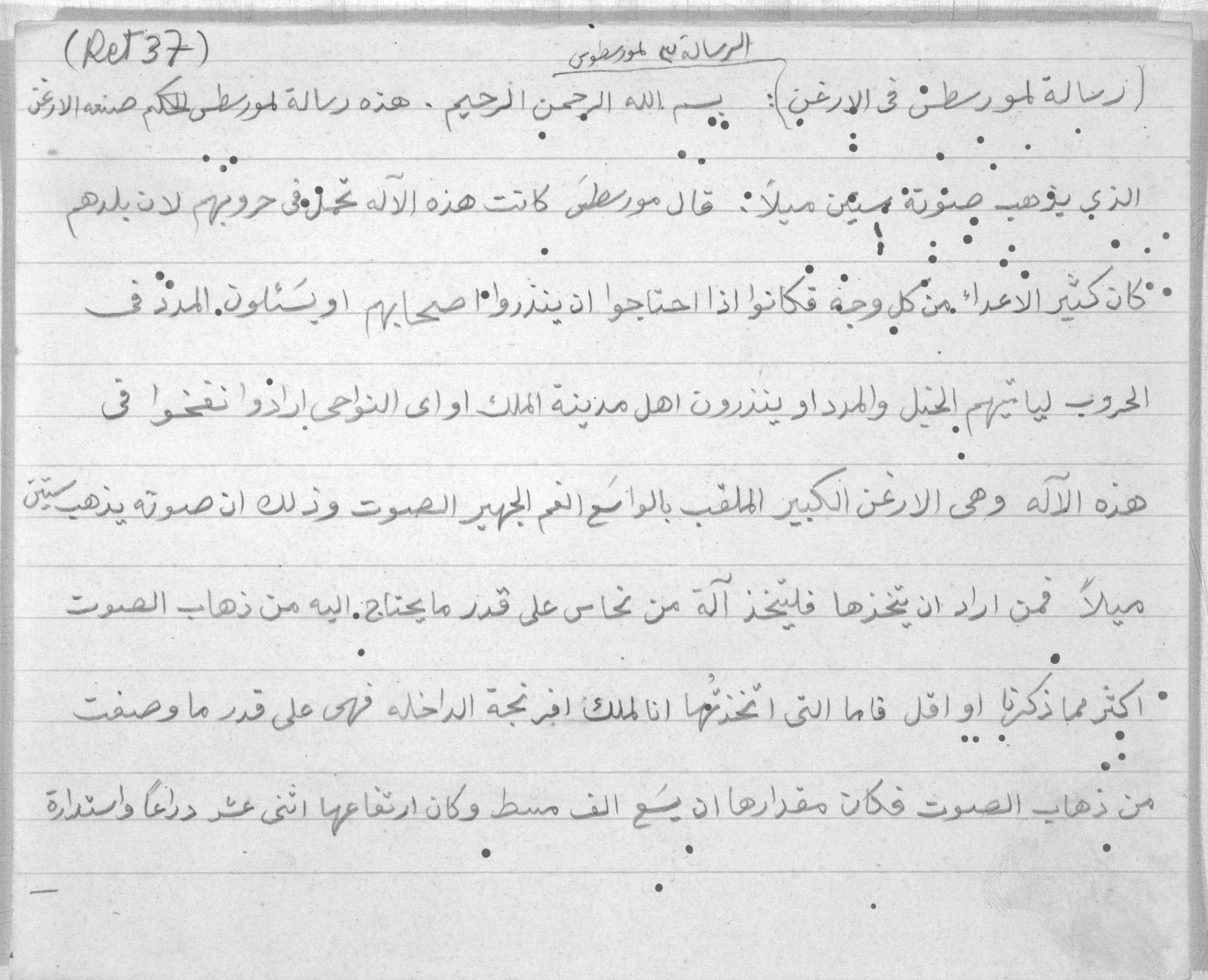The Legacy Of Mūrisṭus’ Hydraulic And Pneumatic Pipe Organs In The Early 20th Century Arabic Literary Culture
The Legacy of Mūrisṭus’ Hydraulic and Pneumatic Pipe Organs in the Early 20th-Century Arabic Literary Culture
This story is part of an ongoing series of editorials in which HMML curators and catalogers examine how specific themes appear across HMML’s digital collections. On the theme of Music, Dr. Celeste Gianni has this story from HMML's Islamic and Eastern Christian collections.

The organ is not the first musical instrument that comes to mind when thinking about Arabic music from the Islamic countries, as the instrument is often associated with Christian liturgy. However, the construction of this musical instrument and its different uses are attested in several Arabic treatises with a keen interest for the aspects of mechanics, hydraulics, and pneumatics involved in its construction.
Within the Arabic manuscript tradition, there are two treatises attributed to an author named Mūrisṭus: a treatise on the construction of a hydraulic pipe organ (Ṣanʻat al-urghīn al-būqī), where the system that makes the air flow in the pipes is based on a water pump; and a treatise on the construction of a pneumatic pipe organ (Ṣanʻat al-urghīn al-zamrī), based on a pneumatic (pressurized air or gas) pump to make the air flow.
The author Mūrisṭus has been tentatively identified by different scholars as: Ariston (an individual who died ca. 220 BCE and was a dedicatee of the Pneumatica device designed by Philo of Byzantium), Ameristos (an early Greek mathematician mentioned in Proclus’ commentary on Euclid’s Elements), and Ctesibius (died ca. 222 BCE). However, there is no certainty about the real identity of Mūrisṭus, and it seems likely that the two treatises about organ construction were produced within the Arabic tradition and were attributed to him to increase their authority through their association with a Greek name.

The two treatises are characterized both by their scientific description of organ construction as well as by their description of the instrument’s use. The hydraulic pipe organ is said to have been an instrument that was carried into battle and used as a siren capable of emitting a blast that could be heard for 60 miles. The pneumatic pipe organ, on the other hand, is said to produce such wondrous sounds that it could cause their listeners to weep, fall asleep, rejoice, dance, and lose their senses.
Mūrisṭus’ treatises are available in HMML Reading Room in manuscript USJ 00224, photographed by HMML in the collection of the Université Saint-Joseph in Beirut, Lebanon.
This manuscript is an interesting example of interaction between manuscript and print cultures at the beginning of the 20th century. The copyist is the Jesuit Chaldean Catholic priest Louis Cheikho (1859–1927 CE), an orientalist and theologian originally from Mardin, Turkey, who made major contributions to the print publication of manuscript texts.

Cheikho was a fervent manuscript collector who greatly enriched the collection of the Université Saint-Joseph, where he studied and thought. He compiled the first detailed catalog description of the Université Saint-Joseph’s collection, and he donated to the library copies he made himself of manuscripts that he saw in other libraries.
USJ 00224 contains a draft of an article that Cheikho published in the famous Al-Machriq, a journal founded by Cheikho in 1898 CE and widely read across the Middle Eastern literary circles and cafes.

The article, published in Al-Machriq (1906, vol. 1, pages 18–28) under the title “Thalāth maqālāt ʿarabīyah fī al-ālāt al-munaghghimah” (Three Arabic treatises on tuning instruments), includes two editions of Mūrisṭus’ treatises on the hydraulic and pneumatic organs. These treatises were revised by Cheikho, based on a manuscript in Université Saint-Joseph’s collection that is currently lost (manuscript 223). In his preface to the texts, Cheikho explains that this manuscript included a broader collection of Arabic texts on engineering and mechanics.
Cheikho’s publication of Mūrisṭus’ treatises was driven by his desire to promote and make known to the world otherwise unknown texts from the Arabic manuscript tradition, in particular scientific texts. Cheikho’s decision to publish these two texts proves a continuity with the past—a 20th century readership interested in the same mechanical, engineering view of an organ and using manuscripts to carry the knowledge forward.




